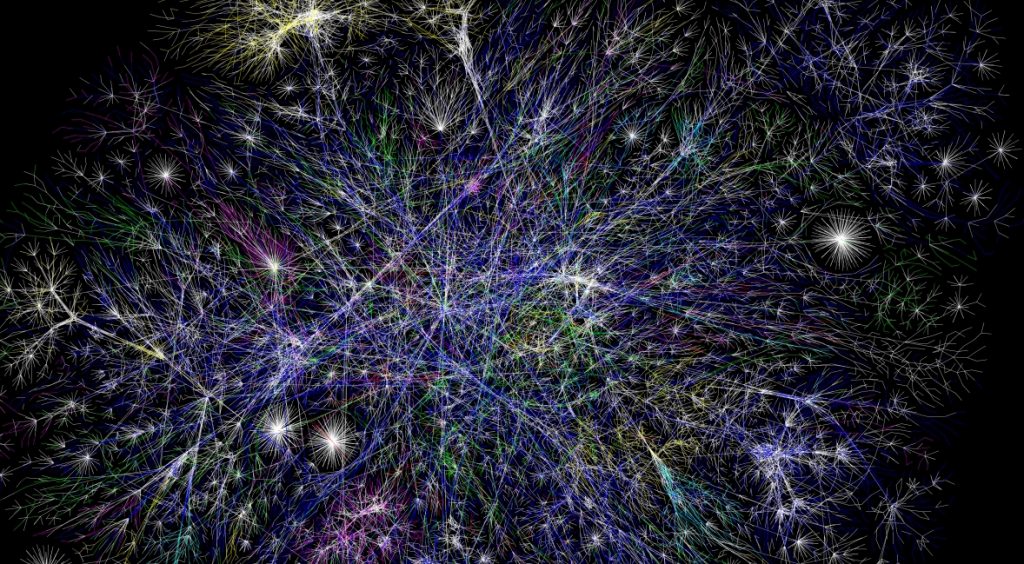
What to watch for
After completing this lesson, you’ll be able to:
- Outline the history of computer networks
- Distinguish between the internet and the web
- Define in broad strokes how computer networks function
- Identify various networking technologies
Like I said in the hardware lesson, we could consider computer networks just another bit of hardware. But networks are different: they’re what enabled so many of the use cases that have driven the recent (and ongoing) exponential growth and importance of computing.
A simple thought experiment proves this: imagine your laptop without wifi, or you phone without a network connection. Both are still amazing marvels of technology and extremely useful. But, I’d be willing to bet that a lack of network connectivity would adversely impact—if not outright prohibit—the overwhelming majority of the things that you use those devices for.
History
Readings:
- “Computer network (Including “History”)“, Wikipedia
- “History of the Internet“, Wikipedia
(1715 words / 9-15 minutes)
The above readings pretty much cover it: networks originated in the military, then spread to academic institutions, then to large technology corporations, then everywhere. Of particular interest is this quote from “History of the Internet” about the speed of the Internet’s adoption:
The Internet’s takeover of the global communication landscape was almost instant in historical terms: it only communicated 1% of the information flowing through two-way telecommunications networks in the year 1993, already 51% by 2000, and more than 97% of the telecommunicated information by 2007.
Make sure you know what ARPA / DARPA and ARPANET are, and that they went live in 1969. You should also know that Robert Metcalfe (of Metcalfe’s Law fame) came up with Ethernet (more on that later) while working at Xerox PARC (more on that in a later lesson) in the 1970s. Minitel, introduced in France in 1978, was pretty far ahead of its time. Finally, you darn well better know that Sir Tim Berners-Lee created the World Wide Web in 1991 (on a NeXT computer).
How the internet and the web work
Readings:
- “How does the Internet work?”, MDN
- “How the Web works“, MDN
- “What is the difference between webpage, website, web server, and search engine?“, MDN
- “What is a web server?“, MDN
- “What are hyperlinks?“, MDN
- “What is a URL?“, MDN
- “What is a domain name?“, MDN
- “How Does the Internet Work?“, Rus Shuler (Stanford)
(11,595 words / 58-75 minutes)
Read through all of the above, in sequence, to build a clear understanding of how the internet and the web actually work. Key things to make sure you know include:
- What IP is
- What an IP address is
- The differences between a generic computer network, the internet, and the web
- What DNS means and what it does
- What a domain name is and how it works
- A bit about packets
- The differences between a web page, a web site, and a web server 1
- What URL stands for and what one is
- What hyperlinks are
- What HTTP and HTML are and the connections and differences between them
As for the Stanford reading, it offers a more technical go at most of the same things outlined in the MDN readings. Be sure to read it, but if some of the denser bits—like, say about NSPs and MAEs—don’t immediately click for you, don’t stress about it. The essential stuff is in the MDN readings; the Stanford stuff is just there for you if it helps (and for review).
Technologies
Readings:
- “Ethernet“, Wikipedia
- “Wi-Fi“, Wikipedia
- “LTE (telecommunication)“, Wikipedia
- “5G“, Wikipedia
- “Dial-up Internet access“, “Digital subscriber line“, “Cable Internet access“, and “Fiber-optic communication“, Wikipedia
- “What’s the difference between a modem and a router?“, How-To Geek
(2237 words / 12-18 minutes)
Ethernet is the main wired interface for connecting computers to local area networks. Wi-Fi (a play on “hi-fi” 2) is the main wireless interface for connecting our computers to local area networks. Cellular data networks use standards like LTE to connect devices to the internet while they’re mobile.
For historical purposes, you should probably know what dial-up and DSL are, as well as cable and fiber-optic network connections.
Finally, you’ll feel extra smart the next time you try to fix your wi-fi if you know the difference between a modem and a router.
Discussion questions
- To think about the importance of networks, imagine your laptop without wifi, or you phone without a network connection—what could you still do? What couldn’t you do?
- What do you think about the origins of computer networking in military applications? In academia?
- Before you read this lesson and its readings, what was your understanding of how computer networks operated? What is your understanding now? What questions do you still have?
- What’s your earliest memory of using a computer network?
- Peeking ahead a bit, think about what happens when everything is networked—welcome to the Internet of Things (IoT)! Though we’ll discuss this in greater detail later, talk now about any experiences you have with the IoT.
- Let’s all take a minute to reflect on the fact that the precursor to the Internet was conceived of by a man named J.C.R. Licklider and was called the Intergalactic Computer Network.
Words on / reading time for this page: 646 words / 4-6 minutes
Words in / reading time for required readings: 15,853 words / 79-108 minutes
Total words in / reading time for this lesson: 16,499 words / 83-114 minutes